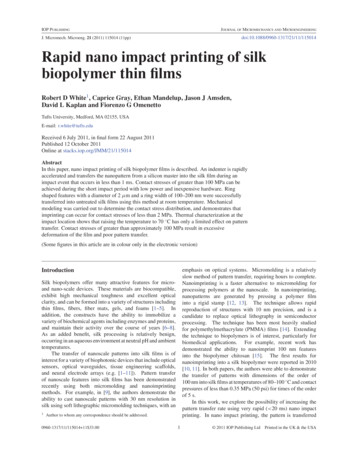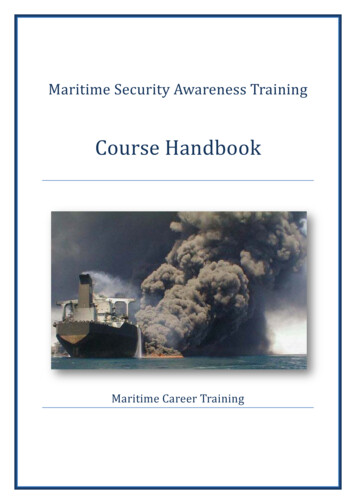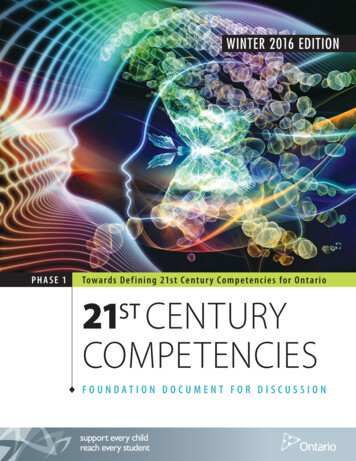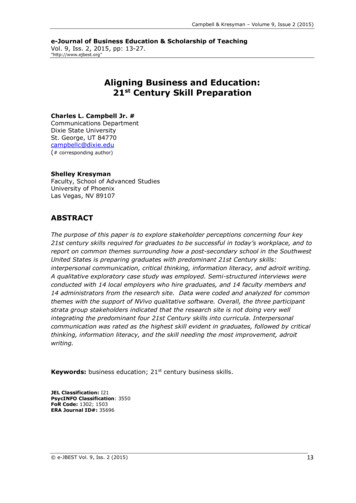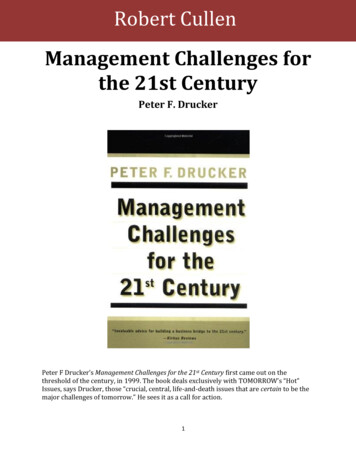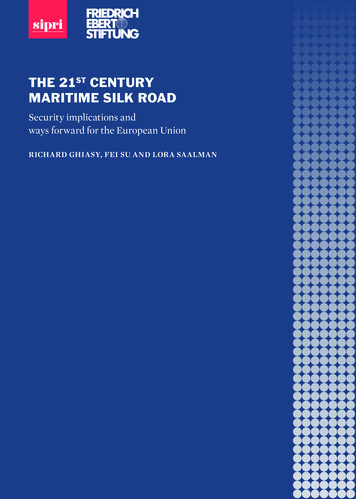
Transcription
THE 21ST CENTURYMARITIME SILK ROADSecurity implications andways forward for the European Unionrichard ghiasy, fei su and lora saalman
THE 21ST CENTURYMARITIME SILK ROADSecurity implications andways forward for the European Unionrichard ghiasy, fei su and lora saalman
STOCKHOLM INTERNATIONALPEACE RESEARCH INSTITUTESIPRI is an independent international institute dedicated to research into conflict,armaments, arms control and disarmament. Established in 1966, SIPRI providesdata, analysis and recommendations, based on open sources, to policymakers,researchers, media and the interested public.The Governing Board is not responsible for the views expressed in the publicationsof the Institute.GOVERNING BOARDAmbassador Jan Eliasson, Chair (Sweden)Dr Dewi Fortuna Anwar (Indonesia)Dr Vladimir Baranovsky (Russia)Ambassador Lakhdar Brahimi (Algeria)Espen Barth Eide (Norway)Dr Radha Kumar (India)Dr Jessica Tuchman Mathews (United States)DIRECTORDan Smith (United Kingdom)Signalistgatan 9SE-169 72 Solna, SwedenTelephone: 46 8 655 97 00Email: sipri@sipri.orgInternet: www.sipri.org SIPRI 2018
ContentsAcknowledgementsKey findings and recommendations1. The Maritime Silk Road1.1. Scope and strategic evolution1.2. Exploring China’s aspirationsvvii1142. The Maritime Silk Road: Security implications2.1. Security implications for the South China Sea2.2. Security Implications for the Indian Ocean Region1111223. The Maritime Silk Road: Prospects for European Union security cooperation3.1. Compatibility with European Union maritime security interests3.2. Ways forward for the European Union333345Annex I. Abbreviations50List of figuresFigure 2.1. Map of the South China Sea illustrating Maritime Silk Roadsecurity implicationsFigure 2.2. Map of the Indian Ocean Region illustrating Maritime SilkRoad security implications and investments1828
AcknowledgementsThis policy report has been funded through the generous support of the FriedrichEbert-Stiftung (FES) and is the second publication of the SIPRI–FES cooperation onthe Belt and Road Initiative (BRI). In these publications we have examined the securityimplications of the Silk Road Economic Belt and the 21st Century Maritime Silk Roadcomponents of the BRI. It has been a great pleasure working with and learning fromFES’ professional, thoughtful and knowledgeable staff. In particular, we would like toexpress our gratitude to Knut Dethlefsen for realizing this project; Stefan Pantekoekand Cilia Ebert-Libeskind for coordinating the project; and Johannes Kadura, AlexeyYusupov, Arthur Tarnowski and their truly wonderful teams for coordinating theworkshops and interviews in the Philippines, Myanmar and China respectively. Theworkshop in Myanmar was kindly co-hosted by the Myanmar Institute of Strategicand International Studies (Myanmar-ISIS) and the workshop in Shanghai by theShanghai Institutes for International Studies (SIIS). We are much indebted.Rarely is a policy report solely the product of the authors’ insights, and this work is noexception. Throughout the course of this nine-month project we have been fortunateto learn from the insights of many analysts in the above-mentioned workshops andinterviews. They have contributed significantly to this report and we are very grateful.In particular, we would like to highlight the generosity of this report’s peer reviewers:Aileen S.P. Baviera, Nicola Casarini, Chen Dingding, Cui Hongjian, Hoang Thi Ha,Gurpreet Khurana, Christopher Len, Garima Mohan, Dulyapak Preecharush, BhagyaSenaratne, Abhijit Singh, Justyna Szczudlik, Gudrun Wacker, Naghmana Zafar andZhou Jiayi.Finally, we would like to acknowledge the fine work of the SIPRI EditorialDepartment and of Christian Dietrich for creating the two figures in this report.Any faults in this report are our own.The authorsStockholm, June 2018
Key findings and recommendationsThis policy report presents an analysis of the security implications of the sea-basedcomponent of the Belt and Road Initiative (BRI), the 21st Century Maritime Silk Road(the Road).1 It complements the February 2017 SIPRI–FES publication on the landbased component of the BRI, the Silk Road Economic Belt (the Belt). 2 The previousreport examined security implications in two of the strategic terrestrial regionsthat the Belt traverses: Central Asia and South Asia. In turn, this report examinessecurity implications in the two strategic maritime spaces that it crosses: the SouthChina Sea (SCS) and the Indian Ocean Region (IOR). As in the previous report, specialconsideration is given to how Road security implications might affect the interests ofthe European Union (EU) and how the EU could consider responding, but the findingsare also of significance and policy relevance to non-EU stakeholders of the Road. Thereport is divided into three chapters.Chapter 1 analyses the scope and strategic evolution of the Road, as well asChina’s economic, political and security rationales that underpin the Road. TheRoad’s geographic scope has been constantly expanding to new waters. Its strategicevolution has more recently been characterized by a greater focus on cooperation oncommon maritime security and ‘green’ development. Particularly when linked withthe Belt, the Road is intended to bridge a vast connectivity gap and has no peers thatapproximate its scale, speed and commitment. While there will certainly be positivespin-offs in terms of development, connectivity and cooperation, there are concernsamong some states about its potential security consequences. Among these concernsis that Chinese ownership of some strategic seaports may come to provide logisticalfacilities for its expanding blue water navy.The Road is destined to serve a range of China’s core interests, these include thedevelopment of its more than 1.2 trillion blue economy, improving food and energysecurity, diversifying and securing sea lines of communication (SLOC), upholdingterritorial sovereignty and enhancing its international discourse power. The Roadhas the potential to expand China’s maritime strategic space far beyond its enclosedadjacent waters and allow it and Road participating states to co-shape the changingglobal maritime order. Within this construct, China, like previous and existingpowers, is seeking to reduce the impact of disruptive forces on key supply chains—theRoad is not anomalous. The initiative will allow China to build resilience to economicor diplomatic isolation that could negatively impact its economy and subsequentlydomestic stability. At the same time, however, by investing in fragile states China istaking substantial risks, which could affect the economy it is trying to protect.In chapter 2, the report details how the Road is interacting with the countries andsecurity dynamics of the SCS and the IOR. China’s maritime renaissance, spearheadedby the Road, adds to the security complexity of the SCS and the IOR. These are securityspaces that are more contested by regional and extra-regional players than the Belt’smost strategic regions. In the SCS, the Road is attractive to most of ASEAN, givenits strong interest in improved connectivity, economic opportunities and good tieswith China. That said, the Road is impacted by and impacts preexisting maritime and1 This policy report is based on a nine-month study. The analysis in this report is based on desk and field research.The desk research made use of Chinese and English language material. Field research involved three workshops and arange of interviews held in Manila, the Philippines; Yangon, Myanmar; and Shanghai, China. Select insights from 94analysts from 60 institutions in 20 countries are included in this report. Both non-traditional and traditional securityimplications are discussed, with an overarching emphasis on maritime security and reactions to the Road in thecountries located along the SCS in South East Asia and the IOR, mostly focused on the littoral states in the northernranges.2 See Ghiasy, R. and Zhou, J., The Silk Road Economic Belt: Considering Security Implications and EU-ChinaCooperation Prospects (SIPRI: Stockholm, Feb. 2017).
viii the 21 st century maritime silk roadjurisdictional disputes. This affects the receptiveness of the South East Asian claimantstates, two of which, Vietnam and the Philippines, are somewhat anxious aboutChinese investment. Beyond this, the Road, at times, also rekindles existing stressesand strains between China and regional states. This dynamic oscillates betweenmoderation in pursuit of common maritime economic development and a shelvingof territorial disputes, and the exacerbation of concerns among some regional statesabout China’s growing footprint and a regional arms build-up. When accompanied byuncertainty over US engagement, as well as the overall lack of an effective regionallyled security architecture and ASEAN cohesion, some of these countries are beset byconcerns over what China’s security vision for the region might look like and howjostling between powers in the region could affect their own security.In the IOR, the Road seeks to create, alongside the Belt, a production and tradenetwork linking this maritime domain with the Eurasian hinterland and WesternChina. This would be a historic first that could contribute to the opening up oflandlocked Central Asia, improved connectivity in South Asia, and greater Eurasianeconomic integration and security cooperation. As a result, the Road in associationwith the Belt could reshape the nature of the IOR into a more interconnected globalcommons that could provide a host of new economic opportunities. In so doing, theRoad has begun to stimulate greater competition over development–support andconnectivity in the region. While this may be a positive trend, it also precipitatesgreater militarization and maritime rivalry in an already complex multi stakeholderregion, in particular between China and the resurging quadrilateral consisting of theUnited States, India, Japan and Australia (the ‘Quad’). By blending complex Eurasianterrestrial and maritime security spaces through the BRI, China is likely to becompelled to undertake a stronger role in IOR security affairs, as is already happeningin Myanmar, the Maldives and Pakistan. This dynamic contributes to unprecedentedChina–Indian security interaction. Furthermore, the Road might facilitate Chinabecoming a resident military power in the IOR and diminish the role of the USA as theprimary security provider, as well as some of India’s envisaged security aspirations.The question arises, however, whether this would produce a sustainable US-IndianChinese security condominium or some alternative that includes the EU or some of itsindividual member states in the Indian Ocean. In the process, the development of theRoad is likely to continue to contribute to an increase in geostrategic overtures andmilitary posturing by both regional and extra-regional actors.Chapter 3 evaluates how EU security interests, particularly maritime securityinterests, in the SCS and the IOR intersect with Road ambitions and securityimplications. In this context, it explores possible avenues for security and economiccooperation with China and regional stakeholders. While Road objectives serveChina’s core interests they are not entirely acquisitive and several of these overlapwith the European Union Maritime Security Strategy (EUMSS) and the EU GlobalStrategy. These include stimulating sustainable global growth of the blue economy,improving local and regional connectivity, facilitating international cooperationon ‘green’ development in the blue economy, and promoting maritime security andstability at large. Indeed, through the Road, China will be increasingly drawn intostabilizing states and regions in order to safeguard its interests. After all, the BRI islikely to remain a red thread in China’s foreign policy. This will certainly generatepositive results in some cases, but such cross-pollination may not always be in line withEU norms and values as they relate to governance models, development approaches,business standards and human security.Based on the findings in chapters 1 and 2, on balance the Road in its currentincarnation may pose more security challenges than solutions for the EU over the
key findings and recommendations ixmedium and long-term. This has more to do with preexisting maritime issues andtensions, the multi stakeholder nature of the SCS and IOR, and some of the practicalsecurity implications of the Road to date than the stated objectives of the Road.These implications are the product of both Chinese approaches and (extra-)regionalstakeholder receptiveness to the Road. The EU and like-minded stakeholders shouldconsider pursuing avenues that could limit these challenges. Ideally, the EU andChina seek greater opportunities for collaboration on maritime security, although therecommendations below indicate that these may be limited in the Road’s context, orat least require more dialogue and creative thinking. One exception, as with the Belt,are the United Nations Sustainable Development Goals (UN SDGs), which offer ampleopportunities for cooperation. The Road, as with the Belt, advances through trial anderror and China may be receptive to revising, if not the objectives, then at least someexisting approaches if a combination of incentives and disincentives is applied.Recommendations to the EU1. Overall, there needs to be greater integration of development as a core tenet ofsecurity, inclusion and stability within the EU’s regional engagement of South EastAsian and IOR states. While this need not obviate its pursuit of democratic andhuman rights ideals, a failure to take better account of regional and individual statedemands and their need for growth will leave the EU marginalized as China expandsits engagement along the Road.2. Rather than undertaking an evaluation of the regions as groups, an EU approachbased on evaluating each country’s non-traditional and traditional security climateand each sector’s investment climate is merited. As economic and strategic engagementare intertwined in this approach, new geo-economic and geostrategic avenues ofengagement should be devised.3. In the SCS, if China gains a stronger economic, financial, diplomatic andmilitary presence through the Road, over time it may gain the leverage to achieve itsmaritime claims, thereby possibly impacting the security of EU SLOCs and freedom ofnavigation. This is a red line and the EU is advised to engage with China, ASEAN andother stakeholders to discuss its concerns and the exact particulars of the maritimesecurity that stakeholders foresee for the SCS. European countries currently engagedin freedom of navigation operations should stand at the forefront of such an approach.4. Greater EU attention to maritime security in the SCS and especially the IOR isfirmly recommended—the relevance of both regions to EU diplomatic, economic andsecurity interests cannot be overstated. The EU would benefit from having a proactivestrategic policy prescription for what the formulation of the Indo-Pacific means forlong-term regional stability, particularly given the security implications of the Road.To begin with it may benefit from a series of track 1.5 workshops on this topic withstakeholders.5. In the IOR, the EU should closely monitor the changes in maritime securitydevelopments led by China, on the one hand, and the Quad, on the other. Rather thantaking sides, the EU should support a peaceful transition to new regional securityarrangements that include its own members, while strategically using the interplayand merger of the IOR’s maritime and terrestrial security spaces to its economic,diplomatic and security advantage.6. This project’s IOR workshop experts from South Asia actively called for the EU toplay a greater role as a regional maritime security coordinator, particularly in the lightof growing tensions between China and the Quad. In listening to these voices from theregion, there are a number of points of entry for the EU to consider. The Indian Ocean
x the 21 st century maritime silk roadRim Association for Regional Cooperation could facilitate economic cooperation,while the Galle Dialogue and the Indian Ocean Naval Symposium provide forums fornaval chiefs.7. Given that fighting piracy, counterterrorism and providing safe passage for thelarge amount of trade between the EU and the Indian Ocean are high priorities amongall actors, the EU could play a central role in establishing and maintaining a code ofconduct by establishing a track 2 platform comparable to the Council for SecurityCooperation in the Asia Pacific or through strategic groupings of external actors inthe region, whether in bilateral, trilateral or quadrilateral formations.8. The EU has a number of local missions within South East Asia and South Asia thatcould be better tailored towards engagement in Road projects with local stakeholders.Doing so may better ensure that economic and security engagement is coordinated,sustainable and inclusive of local needs and security interests, fishing rights andresource exploration.9. EU security interests could possibly be met indirectly through economic avenues.One example: EU companies and member states would benefit from the building ofcoalitions, in an enhanced version of the ‘cluster internationalization’ construct, toenhance economies of scale and bid on local tenders along the Road. This could alsohelp open up the Road tender and bidding processes and lay the groundwork for theintegration of special economic zones (SEZs) in South East Asian and IOR countries.
1. The Maritime Silk RoadKEY FINDINGSThe Road: is constantly expanding its geographic scope to new waters, and is seeking to diversifyand secure sea lines of communication as part of China’s maritime renaissance; intends to meet a range of China’s core interests by pursuing further development of itsmore than 1.2 trillion blue economy, improving food and energy security, upholdingterritorial sovereignty and enhancing its international discourse power; lacks peers that approximate its scale and speed, and in tandem with the Belt could filla substantial maritime-terrestrial connectivity gap and instil a spirit of cooperation ondevelopment, but engenders scepticism over possible security implications; can be seen as a prevention strategy that seeks to strengthen China’s resilience toeconomic or diplomatic isolation that could negatively affect domestic stability; allows China to reap security benefits, while also taking risks, by expanding itsmaritime strategic space far beyond its enclosed adjacent waters; could contribute to China’s economic security by connecting terrestrial and maritimeinfrastructure into a mega production and trade network that is projected to reducethe impact of disruptive forces to key existing supply chains; and adds to the security complexity of the South China Sea and the Indian Ocean Region,which are more contested than the Belt’s strategic regions.This chapter explores what China’s 21st Century Maritime Silk Road (the ‘Road’)entails and the aspirations that underlie it. The scope and strategic evolution of theRoad are reviewed, as well as why China has introduced the Road and how it isintended to serve China’s core interests. The focus is on the strategically significantSouth China Sea (SCS) and Indian Ocean Region (IOR). 31.1. Scope and strategic evolutionThe Belt and Road Initiative (BRI) is a long-term Chinese vision for improved globalconnectivity, expanded production and trade chains, and closer overall cooperation. 4Thus far, the BRI has mainly focused on Eurasia and Africa. 5 The Road, which isthe maritime/coastal component of the BRI, focuses on creating a network of ports,through construction, expansion or operation, and the development of portsideindustrial parks and special economic zones (SEZs).In this way, the Road, in tandem with its terrestrial complement, the Silk RoadEconomic Belt (the ‘Belt’), fills a connectivity gap in large economically heterogeneousparts of Asia and Africa and has no peers that approximate its scale and speed.Alongside the enthusiasm and spirit of cooperation on economic development andconnectivity among some 90 countries and international organizations, including theUnited Nations, the BRI has caused strategic and security concerns among a numberof stakeholders. Among these, the most outspoken are Australia, India, Japan, VietNam and the United States; France, Germany and the United Kingdom in Europe;and critical political elites and non-governmental organizations (NGOs) in some3 The Road also encompasses the Mediterranean Sea, the South Pacific and the Arctic Ocean. In comparison tothe SCS and the IOR, the South Pacific and Arctic Ocean are of lesser strategic importance to global stakeholders,including the EU, but it was also due to time and budgetary limitations that this project was unable to focus on thesemaritime spaces. As it relates to the Mediterranean Sea, Clingendael’s Frans-Paul van der Putten, among others, hasalready conducted useful analyses of the Road’s geopolitical and security implications.4 For more information on what the BRI, and the Silk Road Economic Belt more specifically, entail and its drivers,see Ghiasy and Zhou (note 2).5 The scope of the BRI is continuously growing: Oceania, Latin America and even the Arctic are gradually becomingpart of the BRI vision.
2 the 21 st century maritime silk roadBRI recipient states. 6 A number of these concerns apply to the Road. Moreover, theRoad, and the BRI in general, was elevated by the Communist Party of China (CPC)to the constitutional level following the BRI’s fourth anniversary in October 2017.7This reflects the strong political support from the CPC for sustaining the BRI as a redthread in Chinese foreign policy, and has significantly enhanced the Road’s strategicimportance and longevity. 8 Many observers both within and outside of China havecome to associate the BRI with China’s President, Xi Jinping, and it has become amarker of his ambitious leadership. For years to come, a considerable allocationof Chinese political, financial, economic, diplomatic and human capital should beexpected to be devoted to the initiative. This will be needed, as the Road is continuallyexpanding its geographic scope.At its introduction in October 2013, the Road was oriented towards cooperation withthe Association of South East Asian Nations (ASEAN).9 The geographic scope, however,was not clearly defined. Sixteen months later, in the first official document on theRoad, the initial ASEAN-centred focus had been supplemented by broader maritimecoverage beyond the SCS and into the IOR, the South Pacific, the Mediterranean Seaand the Atlantic.10 In June 2017, China expanded the Road’s reach by incorporating theArctic Ocean into the Road, often referred to as the ‘Polar Silk Road’ (冰上丝绸之路).Hence, the Road currently has three envisaged major arteries. The first andmain artery goes from China’s coast to Europe through the SCS, the IOR and theMediterranean Sea, and into the Atlantic. Its second artery extends from China’s coastthrough the SCS to the South Pacific and then onto greater Australia. The third arteryextends through the Arctic Ocean, passing north-west alongside Russia’s northerncoast to connect with the Nordic region and other parts of Europe, and north-eastpast Canada.11 Importantly, this expanding scope gives China and the states alongthe Road more strategic maritime space in which to act. China’s own maritime spacelacks scope and depth. While China borders four seas—the Bohai Sea, the Yellow Sea,the East China Sea and the SCS—it is enclosed by the Korean Peninsula, Japan, thePhilippines and Viet Nam. This is in stark contrast to US maritime space, which islargely open and exclusive on both the Atlantic and the Pacific side, and the EuropeanUnion (EU), which is only enclosed along its southern fringes by North Africa. Incontrast to the Atlantic and the Pacific, or the most strategic spaces of Central andSouth Asia traversed by the Belt, the SCS and Indian Ocean are more complicated andcontested security spaces to which China’s maritime renaissance adds (see chapter 2).Alongside its expansion in geographic scope, the Road has also undergone astrategic evolution. As an adaptable and evolving initiative, the Road seeks to embraceany strategic opportunity that enhances China’s national strength and serves its coreinterests.12 In particular, this involves sustaining China’s continuing economic growth6 With the exception of Viet Nam, none of these states have yet signed a bilateral memorandum of understandingwith China on the BRI writ large. In practice, little BRI activity has taken place in Viet Nam to date.7 During the 19th Communist Party of China (CPC) National Congress in October 2017, the BRI was incorporatedinto the CPC’s Constitution. ‘Full text of resolution on amendment to CPC Constitution’, Xinhua News, 27 Oct. 2017.8 Wang, Y., ‘“一带一路” �’ [BRI incorporated into CPC constitution: Highlevel dialogue between the CPC and world political parties focuses on participations and contributions], The People,30 Nov. 2017.9 National Development and Reform Commission, ‘Vision and Actions on Jointly Building Silk Road Economic Beltand 21st-Century Maritime Silk Road’, 28 Mar. 2015.10 National Development and Reform Commission (note 9).11 ‘China focus: China publishes Arctic policy, eyeing vision of “Polar Silk Road”’, Xinhua, 26 June 2018.12 There is no consensus on the definition of national strength in China. Yan Xuetong, a professor at TsinghuaUniversity, included three dimensions in his 2005 definition: Economic power, military power and political power. HuAngang, another professor at Tsinghua University, also included economic and military power in his definition, butlabelled technological and strategic power two additional components of national strength. Yan, X., ‘中国崛起的实力地位’ [The rise of China and its power status], Science of International Politics, vol. 2, no. 2 (2005), pp. 1–25; and Hu, A.,‘Zhong Guo Shi Li Jin Ru Shi Jie Qian Lie’ [China’s national strength in top rank of the world], 18 Oct. 2017.
the maritime silk road 3by furthering development of the blue economy, which contributed to 9.4 per cent ofChina’s gross domestic product (GDP) in 2017, or more than 1.2 trillion.13In China, the concept of the blue economy is broadly regarded as ocean-relatedindustry and the utilization of ocean-related resources.14 This approach differs fromthat increasingly found among Western countries and NGOs, where environmentalsustainability, or ‘greening’, has gained more weight in decision-making processes.15Hence, the environmental implications of a number of Chinese Road investments inhost countries and adjacent waters have fuelled criticism among local and Westernstakeholders.16 Moreover, China’s inability to curb domestic air, soil and waterpollution has raised doubts about whether its foreign Road investments will be green.17Against this backdrop, China has been proactively pursuing marine sustainability bypromoting green investment and development, and through international frameworkssuch as the 2016 Paris Climate Agreement. In addition, the Road intends to synchronizeits efforts with the UN 2030 Agenda for Sustainable Development.This shift in approach is also evident in China’s BRI White Paper of June 2017,Vision for Maritime Cooperation under the Belt and Road Initiative. The paper addresses‘green development’ by providing concrete policy guidance, setting up monitoringsystems and proposing cooperation on environmental improvement.18 By contrast, thefirst BRI White Paper, published in 2015, Vision and Actions on Jointly Building the SilkRoad Economic Belt and 21st Century Maritime Silk Road, only briefly referred to theimportance of environmental safeguards.19 The 2017 White Paper recognizes mutual‘maritime security’ as protection from traditional and non-traditional security threatsto good order at sea, and that the Road serves as a key assurance for developing theblue economy. Maritime security was not mentioned in the 2015 document.These documents illustrate how China is learning and adapting as the Roadproject evolves. According to one prominent Chinese BRI-shaper, the initiative is‘barely a five-year old kid that is still making mistakes and still learning’. 20 China isnow seeking to incentivize maritime cooperation in domains of common securityinterest such as maritime navigation security, search and rescue missions andmarine disaster response, as well as maritime law enforcement. 21 Alongside maritimesecurity and ‘green’ development, China has prioritized ‘collaborative governance’,‘innovative growth’ and ‘ocean-based prosperity’. This inter-state cooperation andsynchronization of the maritime development plans of the states along the Road couldencourage the collective tackling of non-traditional security challenges. However, it istoo early to take a firm stance on this. What is evident is that the Road permits Chinato lead and promote maritime cooperation and governance along its routes and coshape the future maritime order.13 China’s State Ocean Administration, ‘2017 年中国海洋经济统计公报’ [Bulletin of statistics on 2017 China’s marineeconomy], 1 Mar. 2018.14 Conathan, M. and Moore, S., ‘Developing a blue economy in China and the United States’, Centre for Americanprogress, May 2015.15 ‘What a “blue economy” really is: WWF’s perspective’, WWF Global, 10 July 2015; and The World Bank, ‘Whatis the blue economy?’, 6 June 2017.16 Cheunboran, C., ‘President Xi’s grand strategic initiatives: Cambodian perspectives’, Cambodian Institute forStrategic Studies, 11 Feb. 2016; and Eisenman, J. and Stewart, D. T., ‘China’s new Silk Road is getting muddy’, ForeignPolicy, 9 Jan. 2017.17 Pike, L., ‘Explainer: Will China’s new Silk Road be green?’, China Dialogue, 11 May. 2017.18 ‘Vision for Maritime C
implications of the Silk Road Economic Belt and the 21st Century Maritime Silk Road components of the BRI. It has been a great pleasure working with and learning from FES' professional, thoughtful and knowledgeable staff. In particular, we would like to express our gratitude to Knut Dethlefsen for realizing this project; Stefan Pantekoek




